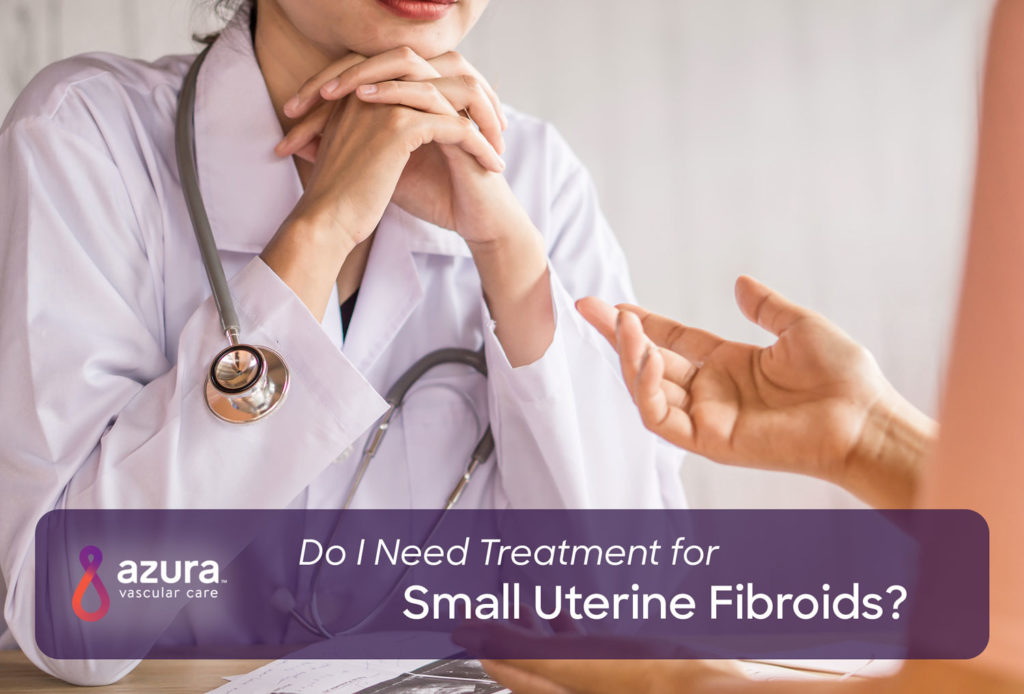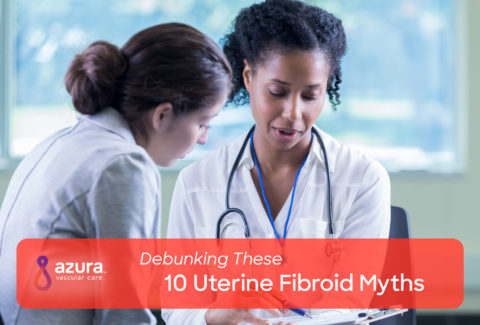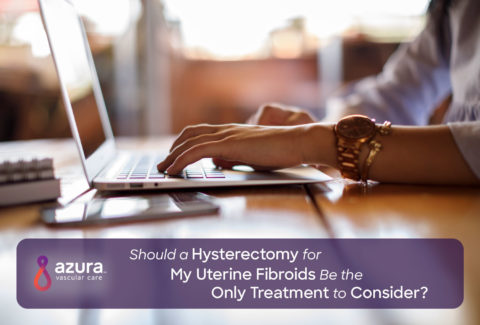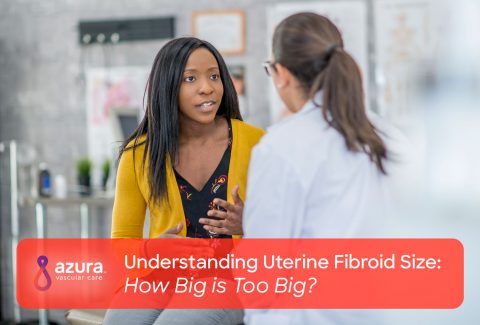
Fibroids—noncancerous tumors that grow in the uterus—can greatly vary in size. Also called leiomyomas or myomas, uterine fibroids often appear during childbearing years. They may be smaller than an apple seed or larger than a grapefruit, and can grow as a single tumor or in clusters. (i)
Your doctor may recommend not treating small uterine fibroids if they aren’t causing any symptoms. Often, watchful waiting—monitoring your fibroids to see if they grow or cause any issues—is the preferred course of treatment for small fibroids.
Can Small Uterine Fibroids Cause Pain?
Many women have uterine fibroids, but most aren’t aware because small fibroids often cause no symptoms (ii). Your doctor may accidentally find fibroids during a prenatal ultrasound or pelvic exam.
Small uterine fibroids can continue to grow and you may develop pain or other symptoms. A fibroid may remain very small for a long time and then suddenly grow very rapidly, or a small fibroid may grow slowly over a number of years.
Uterine Fibroid Symptoms and Complications
Uterine fibroids develop from the muscle tissue of the uterus. They may be located inside the uterus, on its outer surface, within its wall, or attached to the uterus by a stem. Small uterine fibroids can be undetectable to the human eye, whereas large ones can stretch and enlarge the uterus (ii).
Fibroids are most common in women between the ages of 30 and 40 years and occur more often in African-American women than in white women (iii). Fibroids also develop at a younger age and grow more quickly in African-American women (iii).
Fibroids can produce different symptoms depending on their size, number, and location. They can cause pelvic pain, lower back pain and pain during sex. (i, iv) Fibroids can also cause frequent urination, constipation, infertility, repeated miscarriages, heavy bleeding and long menstrual periods. (i) Excessive bleeding due to fibroids can result in anemia (low iron), which may require medical care.
Fibroids that are attached to the uterus by a stem may twist and can cause pain, nausea, or fever. Rapidly growing fibroids or those that start breaking down also may cause pain. A very large fibroid may cause your abdomen to swell, making it difficult for your doctor to do a thorough pelvic exam (iii).
If you are experiencing symptoms of fibroids, the next step is to determine the severity. Are you having heavy menstrual bleeding or symptoms related to the size or “bulk” of the fibroid? Size-related symptoms include pelvic pain and frequent urination.
Call your doctor if you have: (ii)
- Spotting or bleeding between periods.
- Very heavy, prolonged, or painful periods.
- Difficulty emptying your bladder of urine.
- Pelvic pain that doesn’t go away.
It’s important to seek medical care immediately if you have severe vaginal bleeding or sharp pelvic pain that develops suddenly (ii).
Is Surgery Needed for Small Uterine Fibroids?
Although a hysterectomy will completely remove uterine fibroids permanently, it’s not necessary for every woman. Less invasive uterine sparing treatment options are available and include:
- Endometrial ablation—Commonly used to treat women with small fibroids that are less than three centimeters in size, this minimally invasive method destroys the lining of the uterus to reduce menstrual bleeding. (iii)
- Hysteroscopy—This procedure is used to remove fibroids that bulge into the cavity of the uterus. An instrument called a resectoscope is inserted through the hysteroscope and destroys fibroids with electricity or a laser beam. Although hysteroscopy can’t remove fibroids deep in the walls of the uterus, it often can control the bleeding that these fibroids cause. (iii)
- Magnetic resonance imaging (MRI)-guided ultrasound surgery—In this procedure, ultrasound waves destroy fibroids through the skin with the help of MRI. (iii)
If you are considering surgery, it’s important to know that there are increased risks with surgery that may include infection, scarring and blood loss. With medical advancement, there are a variety of nonsurgical options for treating fibroids. Talk to your healthcare provider about the benefits of a minimally invasive, nonsurgical treatment such as Uterine Fibroid Embolization (UFE).
To learn if you’re a candidate for UFE, download our free information sheet, Understanding Uterine Fibroid Embolization (UFE), or call 844-UFE-CARE (833-2273) today to schedule an appointment with a vascular specialist.
Sources:
(i) Parlikar, U. (2015, April 23). No “best” treatment for common uterine fibroids. Retrieved December 11, 2018, from https://www.health.harvard.edu/blog/no-best-treatment-for-common-uterine-fibroids-201504237918.
(ii) Mayo Clinic. (2018, March 06). Uterine fibroids. Retrieved December 11, 2018, from https://www.mayoclinic.org/diseases-conditions/uterine-fibroids/symptoms-causes/syc-20354288.
(iii) American College of Obstetricians and Gynecologists. (2011, May). Uterine fibroids. Retrieved December 11, 2018, from https://www.acog.org/Patients/FAQs/Uterine-Fibroids.
(iv) Office on Women’s Health. (2018, March 16). Uterine fibroids. Retrieved December 11, 2018, from https://www.womenshealth.gov/a-z-topics/uterine-fibroids.


